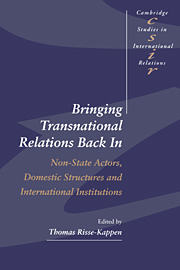 Bringing Transnational Relations Back In
Bringing Transnational Relations Back In Published online by Cambridge University Press: 02 December 2009
We tried to create a new reality by the old methods, sending out directives from above. Well, directives, whether statutes or decrees, are accepted for implementation only by a community that is connected with the command center either by a unity of interests or by bonds of obedience and fear. When these are absent, the directive does not work.
Former Soviet Foreign Minister Eduard ShevardnadzeThis study of the effect of transnational actors on Soviet security policy addresses a country and an issue-area that were left out of the original theorizing about transnational relations in the 1970s. That literature, and the related work on interdependence, assumed that transnational relations would predominate in issue-areas outside the realm of “high politics” and in countries where democratic polities would permit penetration of government policy-making by transnational as well as domestic actors. According to this perspective, the centralized, secretive, and authoritarian regime that prevailed in the Soviet Union until the end of the 1980s was one of the least likely candidates for transnational influence. By the same token, we would expect Soviet security policy to have been the most immune to such influence.
This chapter has two main aims. The first is to present a theoretical rationale for understanding why the Soviet Union should have been open to the influence of transnational actors – in this case, organizations of Soviet and US scientists pursuing arms control initiatives – even in the high politics of security policy.
To save this book to your Kindle, first ensure [email protected] is added to your Approved Personal Document E-mail List under your Personal Document Settings on the Manage Your Content and Devices page of your Amazon account. Then enter the ‘name’ part of your Kindle email address below. Find out more about saving to your Kindle.
Note you can select to save to either the @free.kindle.com or @kindle.com variations. ‘@free.kindle.com’ emails are free but can only be saved to your device when it is connected to wi-fi. ‘@kindle.com’ emails can be delivered even when you are not connected to wi-fi, but note that service fees apply.
Find out more about the Kindle Personal Document Service.
To save content items to your account, please confirm that you agree to abide by our usage policies. If this is the first time you use this feature, you will be asked to authorise Cambridge Core to connect with your account. Find out more about saving content to Dropbox.
To save content items to your account, please confirm that you agree to abide by our usage policies. If this is the first time you use this feature, you will be asked to authorise Cambridge Core to connect with your account. Find out more about saving content to Google Drive.